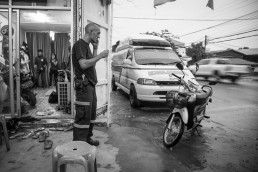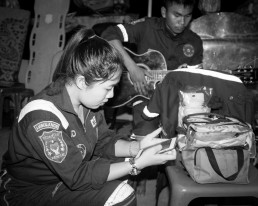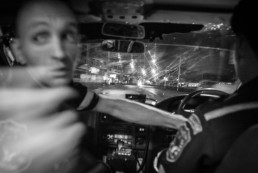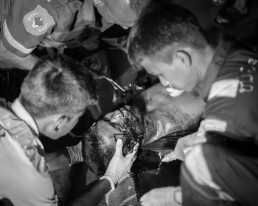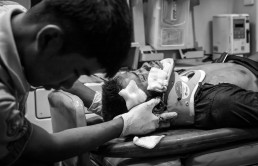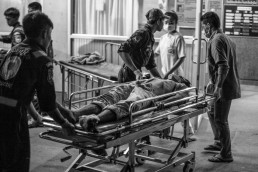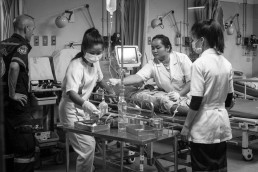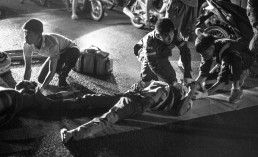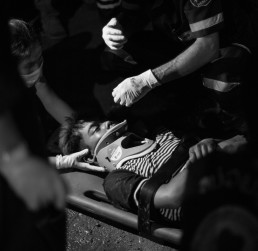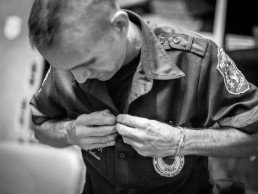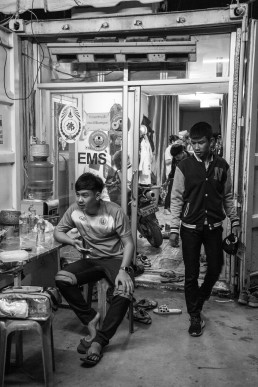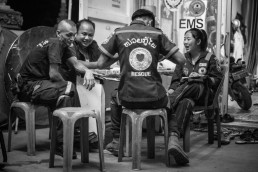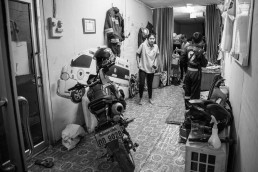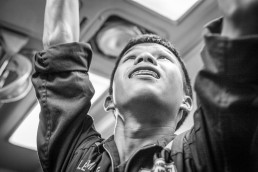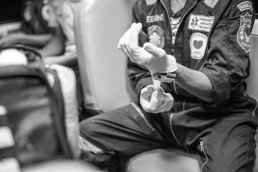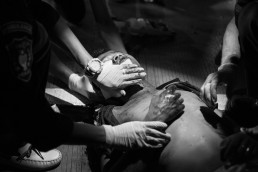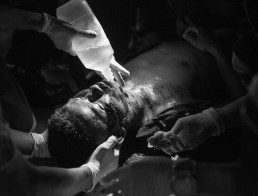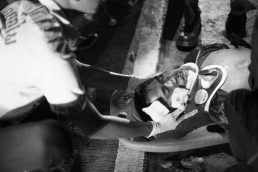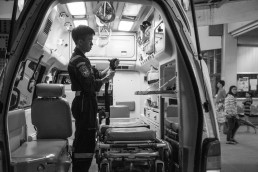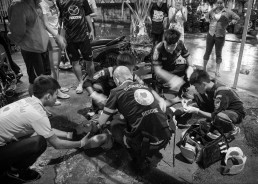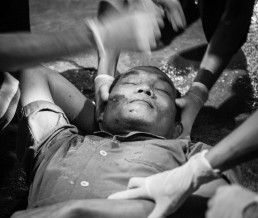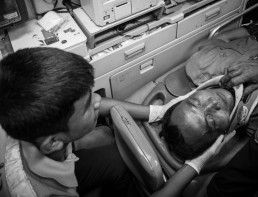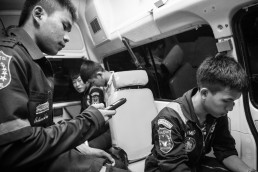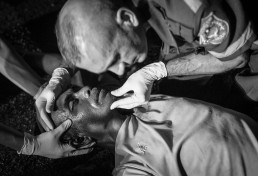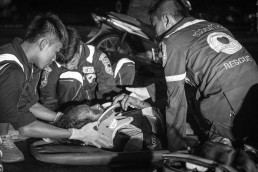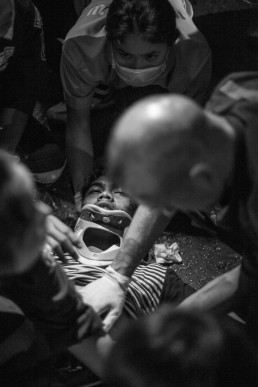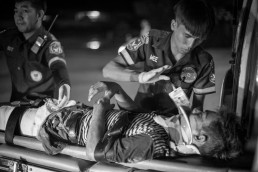The streets of the Laos capital are among the most dangerous in Asia, with road accidents responsible for a disproportionate death rate. But a volunteer emergency service — manned largely by young people and students — offers a lifeline.
THE MAN IS UNCONSCIOUS as the whooping ambulance races towards the hospital. A rectangle of surgical gauze covers the gash in his cheek as we nag and bully our way through Saturday-night traffic, and gobs of dark blood ooze from his right ear, suggesting cranial trauma, possibly a fractured skull. A boyish paramedic presses at the man’s abdomen, searching for signs of internal bleeding.
A second youngster has clipped a pulse oximeter to the man’s finger. The cheap-looking plastic device signals that the oxygenated haemoglobin level in his blood is falling, and Sébastien Perret clambers from the front to administer emergency oxygen.
Just minutes earlier, the unconscious passenger had crashed his motorcycle into a parked people carrier in the Laotian capital of Vientiane. A quick-thinking bystander called Vientiane Rescue, and French native Perret and his youthful first-responder team sprang into action.
The motorcyclist, perhaps in his early 30s, at least now has a chance of survival. Just a few years earlier he would still be crumpled in the gutter, dying slowly in the rain.
LAOS IS ONE OF the poorest countries in Asia. Its capital city, however, is booming and Vientiane’s newfound prosperity has resulted in a torrent of shiny sedans and muscular SUVs, even the occasional luxury Bentley, cruising streets, as well as tens of thousands, possibly hundreds of thousands, of new motorbikes and scooters.
The gore-spilling, bone-crunching downside to the city’s success is a perfect storm of drink driving, endemic speeding, rare use of crash helmets, poor vehicle and road maintenance, and virtually no traffic-safety education or enforcement of road-traffic law. With a population of just 760,000, Vientiane in 2016 has one of the most appalling road-fatality rates in Asia.
Fighting back against the carnage, the 200 or so unpaid volunteers of Vientiane Rescue are increasingly praised as the city’s miracle-working “saviours of the streets”
Making matters worse is the country’s tragically inadequate healthcare system, with no public ambulance service affordable to most pockets. Fighting back against the carnage, the 200 or so unpaid volunteers of Vientiane Rescue are increasingly praised as the city’s miracle-working “saviours of the streets”.
In just a few years, the independent emergency service — which is free of charge and operates 24/7 — has grown from a handful of dedicated individuals (who once slept by roadsides, praying that when emergency calls came they would have enough cash to put petrol into their sorry excuse for an ambulance).
Today, on a budget of just US$6,000 a month, Vientiane Rescue operates eight ambulances, a fire truck, a scuba-rescue team and hydraulic “jaws of life” equipment for cutting trapped passengers from mangled vehicles.
In 2015 alone, Vientiane Rescue responded to 5,760 emergencies. Perret expects the number to rise to 10,000 in 2016.
Most astonishingly of all, the majority of Vientiane Rescue volunteers are students and young people aged 16 to 25. The youngest is just 12 years old. “Some are on standby 24 hours a day for weeks, with just one day off a month to see their families,” says Perret, 38. “That’s 700 hours on standby a month!”
According to the Laos Ministry of Public Security’s Traffic Police Department, from January to October this year there were 1,275 road accidents in the capital, with 215 people killed. Perret knows of 272 road fatalities in Vientiane in 2015.
By comparison, official figures for Hong Kong (an Asian city of 7.2 million people — a population almost 10 times that of Vientiane) show that 122 people died in such accidents in 2015, suggesting that residents of the Laos capital are at least 20 times more likely to be killed on roads than people in Hong Kong.
SATURDAY IS ALWAYS busy for Vientiane Rescue and its four emergency response stations are on alert. The evening starts calmly at the Nong Hai village station, a repurposed 14-metre shipping container positioned beside Boulevard Khamphenmeuang, a major road that’s notorious for speeding, and now slippery following an afternoon of angry thunderstorms. The station is 12 kilometres from Vientiane’s centre and halfway to the landmark Friendship Bridge that spans the Mekong river to connect Laos with neighbouring Thailand.
Dozens of cheap flip-flops are already jumbled at the entrance to the ramshackle station when Perret arrives at 6pm for the evening shift. A floor-to-ceiling curtain hanging halfway down the sea-green container’s length conceals a musty dormitory of bunks catering for up to 10 volunteers on standby.
Outside, plastic spine-board stretchers are stored against the perimeter wall of the adjacent Buddhist temple, its grounds a dark and forbidding tangle of gnarled trees, jungle creepers and graves.
Three young men — minus crash helmets — speed back and forth in front of the station, pulling wheelies on their bikes. “Future customers,” groans Vientiane Rescue founder Sébastien Perret
Previously a primary-school teacher and part-time firefighter in Paris, Perret arrived in Vientiane in 2008. Slight in build and with thinning hair razored into a military-style crop, he has the placid demeanour of an ascetic, though a word he uses often is “passion”. A white banner above the station announces the Vientiane Rescue hotline number 1623 in red. It flaps noisily with every truck that bundles by.
Three young men — minus crash helmets — speed back and forth in front of the station, pulling wheelies on their bikes. “Future customers,” groans Perret, who speaks English and Lao with an unmistakable French accent. Motorbikes and scooters are involved in 95 per cent of all Laos road accidents, according to the Traffic Police Department, with nine out of 10 of the dead being male. It is also estimated that only one in five road users in Vientiane has a driving licence.
“People don’t wear helmets, so most motorbike accidents are very serious,” Perret explains over the din. “They end up dead, in a wheelchair or with severe head-trauma complications. It is illegal to ride without a helmet but there are few police about, especially at night. The problem is huge.”
THE EVENING’S DRAMAS begin when the motorcyclist cannons into the people carrier at about 7.40pm. Once he has been collected from the accident scene, the Vientiane Rescue ambulance arrives at Setthatirath Hospital — four kilometres north of the Nong Hai station — within minutes.
With the four stations and 40 volunteers active at any time during days, and 70 on most nights, Vientiane Rescue has the entire city covered. “Vientiane is small, so we can get to any accident in three to six minutes,” Perret says. “That’s good. The international standard is around 10 minutes.”
The advantages of such efficiency, however, can be thrown away at the hospital. The World Bank reports that in the 10 years to 2015, the the GDP of Laos grew by 257 per cent, reaching US$12.33 billion last year. But the country has one of the world’s most woeful spends on healthcare, averaging just 0.5 per cent of GDP in recent years. Laotians who can afford it rarely use local hospitals but cross the Friendship Bridge to be treated in Thailand.
Those who cannot, however, must stay closer to home, where treatment is cheaper. The Communist Lao People’s Democratic Party, which has ruled the one-party state since 1975, gave up on free healthcare in the 1990s, and Vientiane’s hospitals are poorly equipped and manned by insufficiently trained staff. Setthatirath has just two doctors on duty for emergencies. The city’s Mittaphab Hospital has the only dedicated trauma centre for the entire country.
Surprisingly, Vientiane hospitals do have their own ambulances but they charge for their use and so they largely sit idle. Before Vientiane Rescue came along, bystanders might have heaved a road-accident casualty into a tuk-tuk (an extremely dangerous move in the case of spine or neck injuries). And without sufficient cash for treatment, it would not be uncommon for a seriously hurt person to be left bleeding or screaming in a hospital corridor until necessary funds were found.
Perret sympathises with doctors and nurses working under such grim conditions. Ensuring Vientiane Rescue’s survival has, after all, been a constant struggle, the team often having to make do with second-hand and out-of-date equipment, even having to wash bloodied bandages to be used multiple times.
“When we take an accident victim to the hospital, once there we must remove our cervical collar because we can’t leave it behind and waste money,” Perret says. “Sometimes they have no collars of their own at the hospital as replacement.”
Ultimately, Vientiane Rescue’s success lies with its volunteers, whom Perret praises for their dedication and resilience. “They are very special,” the Frenchman says. “The most amazing people I have ever met, with a real passion for helping others. They give everything. Many are students but we also have people working for NGOs, policemen, shop assistants, soldiers, sailors, workers, whatever.”
Vientiane Rescue took on the team’s youngest member at the request of the boy’s mother. The 12-year-old was proving a tearaway and she was at the end of her tether.
“The mother was alone — the father had gone — and the kid was out every day, missing school and meeting bad people,” Perret says. “One day, she brought him to one of our offices and asked us, desperate, to take care of him. Our volunteers have never learned to say no, so they took him in, for a week at first.
“He was kind of tough, but after the week running on-board the ambulance, he started to understand the meaning of our work and maybe to find himself meaningful. He changed. He started to respect his mother and to listen to her. He’s now polite, respectful — and he’s still coming to our office every day.”
Thirteen-year-old “Ton”, son of the volunteer who heads up Vientiane Rescue’s fire-fighting team, also joined at 12. “He always wanted to come along in the ambulance, but I always refused” Perret says.
“Then, one time we got in the ambulance and he was right behind me. I told him, ‘Get out! You’re too young.’ He said, ‘You forgot your first-aid bag. I brought it to you.’ That was a special moment — I realised that the most important thing was his will, nothing else.
“He was full of passion already, a passion that can move people, a passion that we all need to have and feel. Since that day, he’s welcome on board our ambulances. He’s 100 per cent part of our team. He even has his own uniform.”
WITH THE UNCONSCIOUS motorcyclist stretchered into the hospital, Leeming Manivong scrubs blood from the rear of the ambulance. The softly-spoken, 17-year-old student, braces glinting on his teeth and with pristine-white moccasin shoes poking incongruously from his navy blue Vientiane Rescue uniform, lives with his parents but goes on standby after classes most days, sleeping at the station and seeing his family only on weekends, usually on Sundays.
“My brother used to drink and drive, spending all his free time with friends in discos and partying all night,” the teen confides later. “But then, two years ago, he joined Vientiane Rescue as a volunteer and I saw him change. He stopped drinking and hanging out with his old friends, and spent more and more time with the team. I started to visit him while on duty and the team welcomed me like I was one of them.”
The crew is about to return to base when another call comes in, and burly paramedic Anoukhong Keoounheuan, the Nong Hai station chief and its main ambulance driver, flicks the siren on again and his vehicle back into gear. Keoounheuan has the unflappable, seen-it-all mien of an old emergency hand. He is 28.
“Alcohol is a real issue here … People drink a lot. Stay at the hospital for just one hour and watch the people coming in, and you will see”
Sébastien Perret
Most of Vientiane’s roads lack adequate street lighting but Keoounheuan knows when to put his foot down and when to drive cautiously, especially when manoeuvring a right-hand-drive vehicle in a left-hand-drive country (the ambulance is a decommissioned vehicle that Vientiane Rescue picked up for free from emergency services in Tokyo, paying only for its shipping).
Keoounheuan also has the knowledge to avoid the city’s worst potholes, which the afternoon’s rain has filled, making them difficult to see, and a middle-aged man on a scooter has collided with a deep one.
Keoounheuan positions the ambulance to shine its headlights on the man, who squirms semi-conscious in the street, and a gathered crowd backs off deferentially when the volunteers approach. Perret leans in close to check the man’s breathing, shining a torch into his eyes. “Look at me, look at me,” Perret demands, to no avail. As with the earlier accident, the Frenchman suspects alcohol has played a role in the smash.
VIENTIANE ENJOYS A wholesome reputation as an easy-going city of quaint French colonial-era villas on frangipani-lined boulevards, with ethereal monks occasionally gliding from Buddhist temples — a gentle place where the perils of modern life have been kept at bay. The truth is somewhat different.
According to the World Health Organization, cheap booze makes Laos the second biggest consumer of alcohol in Southeast Asia after Thailand, and the rate of people getting blitzed in freewheeling Vientiane is likely to exceed the national average. Commercial versions of Lao-Lao, the popular Laotian rice whisky, sell for less than a dollar a bottle and are typically 45 per cent proof. Homemade hooch can be stronger.
“Alcohol is a real issue here,” says teetotal Perret, who approximates that drink is a factor in 80 per cent of road accidents handled by Vientiane Rescue. “It doesn’t fit in with the usual image of Laos but people drink a lot,” Perret continues. “Stay at the hospital for just one hour and watch the people coming in, and you will see.”
Perret has described Vientiane Rescue’s story as “the story of a miracle”, and its origins can be traced to 2007, when a grassroots initiative called the Foundation for Assisting Poor People of Lao People’s Democratic Republic (FAPL) used a donated ambulance to provide a rudimentary first-aid service, but only on weekends.
Perret’s crusade to bring a fully functioning ambulance service to a poor Asian country almost 10,000km from his “City of Light” hometown began three years later, when he witnessed a serious road accident and was horrified that no emergency service came to assist.
Perret offered his services to FAPL and Vientiane Rescue was soon established by the Frenchman and six Laotian volunteers, five being just 15 years old at the time (all seven founders are still active today).
Perret says established NGOs sneered at their “insane idea” but gradual progress was made. Then, in January 2012, the group’s ambulance was taken out of action and volunteers began deserting.
A characteristic that defines Vientiane Rescue, however, is its never-say-die attitude. With a one-off financial gift from an angel sponsor, in January 2013 a near-wreck of a Toyota Hilux pickup was purchased and converted into an improvised ambulance. The service’s unlikely resurrection was complete by April.
Today, 150 of its frontline volunteers are trained as first responders and 14 as emergency medical technicians at the respected National Institute for Emergency Medicine in the Thai city of Khon Kaen, with experts coached in rescue diving, fire-fighting and hydraulic rescue.
Financial sponsors have included the Australia, Luxembourg and United Kingdom embassies in Laos, companies such as Toyota and Bosch, and the state-run Lao Lottery. Most funding, however, comes from individuals, with many donations amounting to just a few dollars each.
Perret loses his cool when discussing how some large corporations he has approached for support insist on “benefits and visibility” in return. “That’s such a disgusting lack of respect,” he spits. “Really, it’s amazing that they make demands when our young volunteers give so much for nothing.”
Recognition is coming, however. In August, Vientiane Rescue landed a Ramon Magsaysay Award, which has been called Asia’s equivalent of the Nobel Prize. The Ramon Magsaysay Foundation praised the service’s “heroic work in saving Laotian lives in a time and place of great need, under the most deprived of circumstances, inspiring by their passionate humanitarianism a similar generosity in many others”.
In November, French President François Hollande handed Perret and Vientiane Rescue a prestigious La France S’Engage award at a ceremony in Paris.
HAVING RETURNED TO the Nong Hai station, Keoounheuan has just wrenched on the ambulance’s handbrake when there’s another emergency, and we tear southward to a crossroads where two unconscious men are sprawled in the road on their backs. They appear to have fallen from the same scooter with no other vehicle involved (though hit-and-run incidents are on the rise in Vientiane. By August 26, there had been 23 reported cases in the city since the start of the year, with police citing a main cause as intoxication).
A second Vientiane Rescue ambulance arrives within seconds and the two youthful teams act without speaking, all mimicking Perret’s trait of measured haste. The youngsters make on-the-spot assessments of injuries, stabilise victims, employ cervical collars to immobilise heads and necks, and check for breathing difficulties.
Perret inserts an oropharyngeal airway (a purpose-designed tube employed to stop a patient’s tongue hampering the ability to breathe) into one man’s throat. Soon, both casualties have been carefully scooped up. Within minutes we are back at Setthatirath.
“I was selfish. But four years ago, I was in a car that was hit by another car, and I wasn’t wearing a seat belt”
Vientiane Rescue volunteer Nid Niravanh
There, the rider who accidentally discovered the rain-hidden pothole is now awake and shambling around the car park. His right cheek is swollen and a buckled cigarette dangles from his spittle-flecked lips.
The man who smashed into the people carrier remains unconscious in the emergency ward. His mangled face has been haphazardly stitched back together but his prospect of full recovery, Perret believes, is now slim.
The frantic 90 minutes has been typical for a weekend evening, Perret says, though the incident-free hour to come offers welcome respite. When the team finally returns to Nong Hai station, one young volunteer lazily strums a guitar by the roadside while others sit cross-legged inside playing cards. A polystyrene box of Cantonese-style barbecued pork is passed around, and Manivong stretches out on a wheeled gurney, his face illuminated by the blue-white glow of his smartphone.
ONE OF THE MORE outgoing volunteers is Nid Niravanh, a 22-year-old accountant who chooses to be on standby more or less full time, taking small paying jobs to survive. Ostensibly she lives with her mother, who she now sees once a week.
“I was just an average girl who liked to ride her scooter without caring about others,” Niravanh says of life before volunteering. “I was selfish. But four years ago, I was in a car that was hit by another car, and I wasn’t wearing a seat belt. One my friends was severely injured and I had a head trauma myself. Vientiane Rescue had shut down at that time because of lack of funding, so nobody came to help.
“Then, two years ago, I saw an accident and Vientiane Rescue arrived on the scene very quickly. They were so caring and organised. I wanted to be part of it.”
The final emergency of the evening’s shift occurs almost directly outside Setthatirath Hospital at about 11pm. Again, the injured man is a motorcyclist — seemingly in his mid-20s — and he has collided head-on with a minivan. The accident’s violence has broken his left femur and he bleeds, a glossy puddle of crimson spreading on the damp tarmac.
This time the young women in the rescue crew, including Niravanh, take control, bandaging his leg while reassuring the man, who remains awake, his eyes wide and his breathing fast from shock and panic. Perret says his wound is such that the motorcyclist might, without professional help, have bled out and died, even with a hospital’s emergency room less than 200 metres away. Now, Perret believes, he will survive.
What’s more, the young man’s leg will likely be saved. Until recent years, the main cause of losing a limb in Laos was explosives left over from the Vietnam War (from 1964 to 1973, half a million US bombing missions dropped more than two million tons of ordinance on Laos, making it the most heavily bombed nation in history. One-third failed to detonate). Today, road accidents are more likely to blame.
Later, with 2am approaching and the shift winding down, fresh volunteers arrive and others shuffle from the station’s dormitory, rubbing sleep from puffy eyes. Those who have been working for hours appear reluctant to pass over the baton. Perret believes that while scraping smashed bodies off streets day after day, week after week, can be heartbreaking, it also bonds the youngsters together.
“I feel sad that often we arrive at an accident, resuscitate a victim, take him to the hospital and then two hours later learn that he died,” teenager Manivong admits. “Sometimes I feel helpless, but I place my hope in the team. I’m proud to work with the others and to be part of this story.
“We don’t perform miracles every day, but we try.” ◉
This long-form feature ran in Post Magazine in 2016. Download PDF.
SHARE


